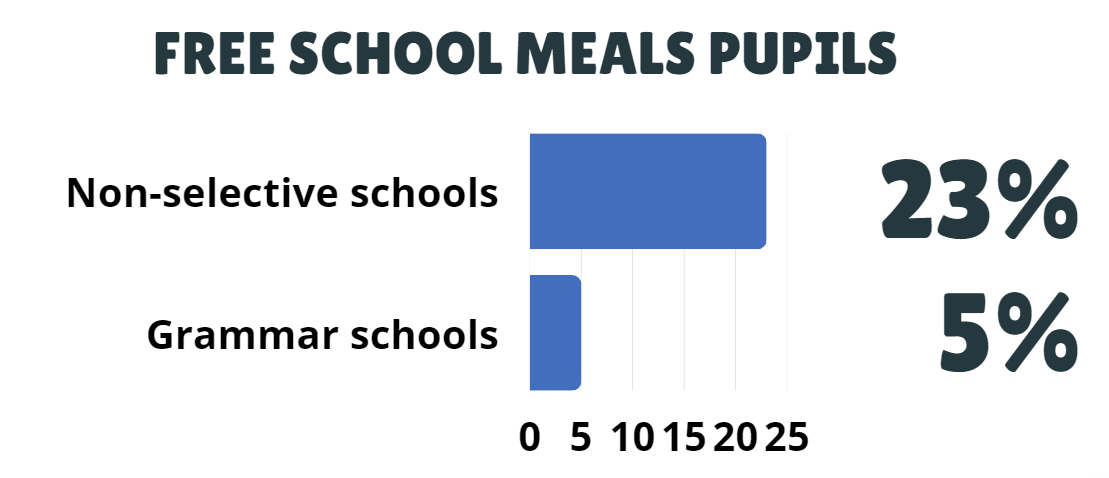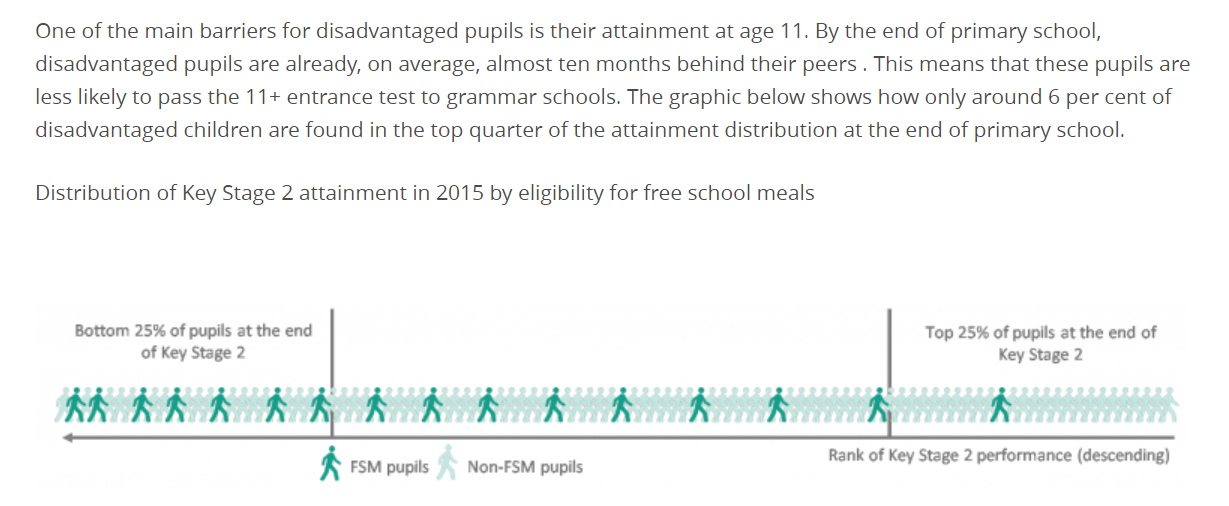 There is a misconception that because there are a relatively small number of grammar schools remaining in England this is why they are monopolised by wealthy families. There is often a suggestion that if there were many more grammar schools they would admit a much higher proportion of disadvantaged pupils.
There is a misconception that because there are a relatively small number of grammar schools remaining in England this is why they are monopolised by wealthy families. There is often a suggestion that if there were many more grammar schools they would admit a much higher proportion of disadvantaged pupils.
Grammar schools typically admit just 5% free school meals (FSM) pupils, while the average proportion of FSM pupils in other secondary schools in selective areas is 23%. Many people believe that the reason for the low numbers of poorer pupils is that grammar schools are oversubscribed and monopolised by the offspring of middle class parents who live miles from the area. This is simply not true, and here’s why.
The vast majority of grammar schools admit all local pupils who pass the 11-plus
Only a handful of grammar schools select the highest scoring pupils wherever they are based. In counties like Kent, Buckinghamshire and Lincolnshire a local 11-plus test is set and grammar schools typical have admission rules based on a test pass plus a catchment area or distance from school. This means that in most selective counties there is not a fight for places, all local children who pass the test will get a place.
As the largest selective county, Kent is perhaps the best example of what would happen if a grammar school system was introduced throughout the country. Kent has 32 grammar schools and 68 non-selective secondary schools, in diverse communities ranging from deprived towns to leafy commute-belt towns in West Kent. The grammar schools admit local pupils who pass the Kent Test, and are regularly not oversubscribed, but instead need to fill places through appeals, with many Kent grammars admitting dozens of pupils who did not pass the 11-plus to fill their empty places. It is clear that the low numbers of disadvantaged pupils in Kent’s grammar schools are nothing to do with a shortage of places at all.
Much of Kent is surrounded by coast, and obviously out of area pupils can’t swim to the grammar schools! Coastal towns such as Dover and Folkestone have high levels of deprivation. These are good examples of what might happen if a grammar school was placed in any deprived area of the country. Department for Education data shows that the town’s non-selective schools admit 48% and 51% pupils who were eligible for free school meals at any time during the past 6 years, while the town’s two grammar school each admit 16% of pupils in this category. This is a significantly lower proportion of disadvantaged pupils than the area average. It is also worth bearing in mind that pupil who have received free school meals at any time in the last 6 years will be a higher figure than those currently receiving free school meals and experiencing current deprivation.
The real reason there are low numbers of disadvantaged pupils in grammar schools
The Grammar School Heads Association in recent meetings with the Department for Education discussed the fact that the reason there are low numbers of disadvantaged pupils in their schools is because only 5% of the highest attainers in KS2 Sats are disadvantaged pupils. The fact that few free school meal pupils are admitted to grammar schools is because the vast majority of poorer pupils who sit the 11-plus do not pass the exam.
The Education Policy Institute identified this issue, and explained the problem. They cited the fact that only 6% of Free School Meal pupils are in the top 25% for attainment, which is generally the standard required to be admitted to grammars. If there are so few high attaining disadvantaged pupils it is unrealistic to expect grammar schools to be inclusive schools educating many more free school meals pupils.
It is clear that if there were many more grammar schools they still wouldn’t fill with poorer pupils, because by the time children sit the 11-plus, an attainment gap is already very evident.
The idea that more grammar schools are needed is flawed policy for a great many reasons, but the idea that their current problem with low numbers of disadvantaged pupils would be fixed by building many more is clearly not based on sound evidence.
Read more from our grammar school myths series HERE.






